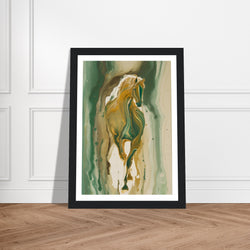When we think of influential female artists, Frida Kahlo is undeniably a name that comes to mind. Her distinctive style, powerful imagery, and passionate exploration of identity and gender have captivated audiences for decades since her death in 1954. As we reflect on her life and art, it becomes evident that Kahlo's influence on the art world is nothing short of remarkable.
A Unique Perspective
Born in 1907 in Mexico City, Frida Kahlo faced a myriad of challenges throughout her life. At the age of six, she contracted polio, which left her with physical disabilities that would plague her for the rest of her life. Then, in 1925, Kahlo was involved in a tragic bus accident that caused her unimaginable pain and left her bedridden for extended periods of time. It was during her recovery from this accident that Kahlo truly began to explore her passion for painting.
Kahlo's artwork often depicted her physical and emotional pain, as well as her complex relationship with her Mexican heritage and indigenous roots. It was through her art that she found solace, self-expression, and a way to navigate the tumultuous experiences she endured.
Iconic Self-Portraits
One of the most distinctive aspects of Kahlo's work is her use of self-portraiture. Throughout her career, she created over 50 self-portraits, in which she bared her soul and exposed her most intimate emotions. By using herself as the subject, Kahlo was able to convey her personal experiences and innermost thoughts in a way that resonates with audiences to this day.
Her self-portraits often incorporated elements of Mexican folk culture and symbolism, such as indigenous clothing and traditional motifs. Through these powerful images, Kahlo challenged societal norms and expectations, especially regarding women and their place in society. She embraced her own unique identity and used her art to explore themes of gender, identity, and sexuality.
A Feminist Trailblazer
Frida Kahlo's unabashed exploration of her own identity and her fearless portrayal of women have made her a powerful feminist icon. At a time when women were expected to conform to traditional gender roles, Kahlo unapologetically showed her pain, vulnerability, and strength through her art. She defied societal expectations and became a symbol of empowerment for women around the world.
Kahlo's art is characterized by its raw emotional intensity, often depicting themes of childbirth, marriage, and miscarriage. These deeply personal experiences were transformed into universal symbols of female strength and resilience.
A Lasting Impact
Decades after her death, Kahlo's impact on the art world is still palpable. Her unique blend of surrealism, symbolism, and personal narrative continue to inspire artists of all genders and backgrounds. Her influence can be seen in contemporary art, fashion, and even popular culture.
Frida Kahlo's artwork has been exhibited in major galleries and museums around the world, including the Tate Modern in London and the Museum of Modern Art in New York. Her iconic image has been reproduced on various forms of merchandise, from t-shirts to tote bags, further solidifying her status as a pop culture icon.
A Timeless Legacy
Frida Kahlo's influence and lasting impact on art extend far beyond her own lifetime. Her art serves as a powerful testament to the resilience of the human spirit, the complexities of identity, and the importance of self-expression. As we continue to celebrate her life and work, Frida Kahlo's legacy remains as vibrant and relevant as ever.
In conclusion, Frida Kahlo's unique perspective, iconic self-portraits, feminist trailblazing, and lasting impact on the art world have solidified her status as an artistic icon. Her art continues to captivate and inspire audiences worldwide, reminding us of the power of self-expression and the beauty of embracing our own unique identities.







